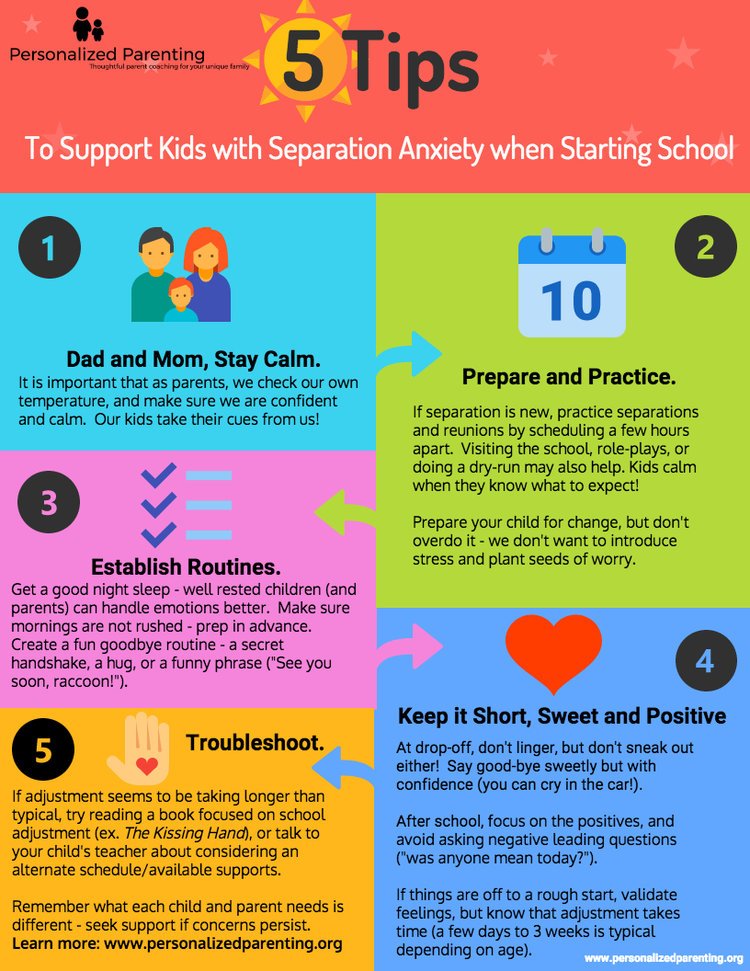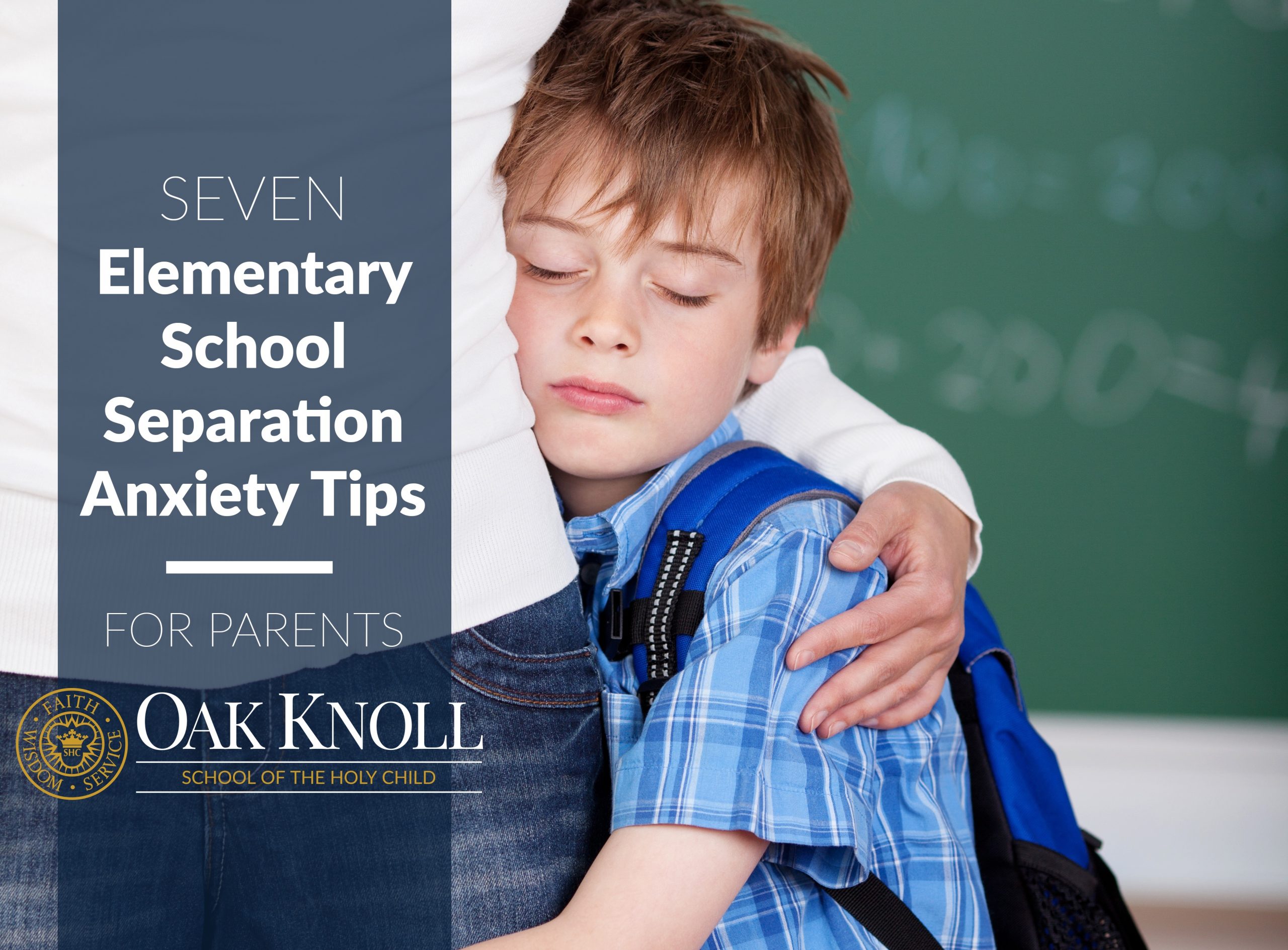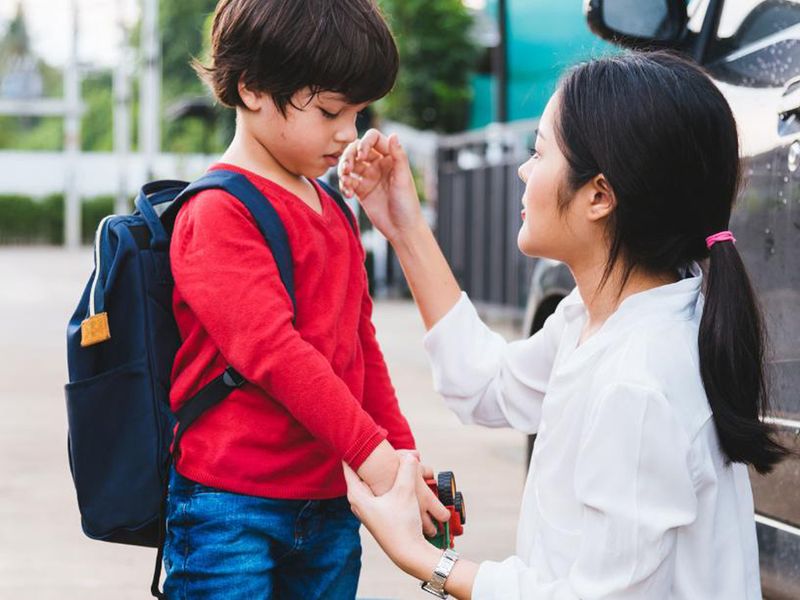Something Sentimental To Remind Them Of You
Give your child something they can hold onto that has sentimental value and will remind them that even though youre apart you love them and you are coming back.
This could be literally anything a piece of matching jewelry, a clothing item, a small toy from your childhood, a picture of the two of you together, etc.
Get Your Child Comfortable With The School
Have A Consistent Routine
Children need structure, plain and simple. Some more than others.
The more predictable your childs day is the less anxious they will feel.
As important as the separation plan is the consistency of the pick-up routine.
If you can get to the school a couple minutes before the bell so your child sees you as soon as they come out the door. Standing and waiting for you, looking around and not seeing you as the other children leave may amplify their anxiety.
If you are going to be late call the school/their childcare provider, or them if theyre old enough to let them know you are safe and you are coming.
Whenever possible the same person should be picking your child up every day.
You May Like: What Causes Early Morning Anxiety
Older Children And Separation Anxiety
What about children who are still experiencing anxiety at the prospect of being away from their parents well into their school years? Well, while a little worry about leaving mom or dad when older is totally normal , intense fear which keeps a child from experiencing and enjoying normal activities may be categorized as .
While the signs of SAD are similar to those of separation anxiety, they are more extreme and prolonged and may include:
- Excessive tiredness due to lack of sleep/nightmares about being alone.
- Being worried when away from home or family .
- Anxious about the safety of a particular family member.
- Fear of becoming lost.
- Refusing to go to school.
- Fearful of being alone, even in safe environments .
- Frequent tummy aches, headaches, or other physical complaints.
- Excessive worry about personal safety.
- Panic resulting in temper tantrums, crying, or lashing out at times of separation from parents.
Browse social and emotional learning resources ready for your classroom!
Tip #: Prepare Your Child For What Is Coming

Feeling prepared makes a change feel way less intimidating than going in blind. Over the last few weeks of summer break, sit down with your child and talk through what will happen. Go over your drop-off and pick-up plans and, if possible, tour your childs school, so they dont feel lost on the first day.
Read Also: How To Calm Stress And Anxiety
Tip #: Practice Leaving
If you notice your child is more attached to you than others and you have a trusted adult you can leave them with, do so. Even if its for just a few minutes or an hour a few days a week, doing this will get your child used to you not being around all the time.
Its understandable that not everyone has family near them so hiring a babysitter for this is another option if you have the means to. If hiring someone is out of the question, I suggest looking for free childrens events going on around you.
These events can be at places like libraries, places of worship, or community centers in your neighborhood. While you may not be able to leave the premises during programs, you can try to distance yourself from your child little by little to get them acclimated.
Common Causes Of Separation Anxiety Disorder
Common causes of separation anxiety disorder in children include:
Change in environment. Changes in surroundings, such as a new house, school, or day care situation, can trigger separation anxiety disorder.
Stress. Stressful situations like switching schools, divorce, or the loss of a loved oneincluding a petcan trigger separation anxiety problems.
Insecure attachment. The attachment bond is the emotional connection formed between an infant and their primary caretaker. While a secure attachment bond ensures that your child will feel secure, understood and calm enough for optimal development, an insecure attachment bond can contribute to childhood problems such as separation anxiety.
An overprotective parent. In some cases, separation anxiety disorder may be the manifestation of your own stress or anxiety. Parents and children can feed one anothers anxieties.
If it seems like your childs separation anxiety disorder happened overnight, the cause might be something related to a traumatic experience rather than separation anxiety. Although these two conditions can share symptoms, they are treated differently. By understanding the effects of traumatic stress on children, you can help your child benefit from the most fitting treatment.
Read Also: Is Alcohol Bad For Anxiety
Tip #: Create Feel Good Lists For The Year
Feel-good lists are really helpful for getting your child excited for the upcoming year. The premise is to have your child list 3-5 things theyre excited about for the school year. You could use fun markers and paper to write down and decorate a list to hang on your refrigerator, or you could have your child tell you in conversation.
Personally, I prefer creating and decorating the list on paper because it allows your child to express their personality. It also gives you another opportunity to make memories together. Along with that, itll serve as a constant physical reminder of the things theyre looking forward to.
Should We Use Home School Or Cyber School To Help Children With Separation Anxiety Who Refuse To Attend Traditional School
If homeschool or cyber school is utilized for children with separation anxiety, it is important that students behavioral and social-emotional needs are addressed through community outlets such as therapy, sports, art, music, groups/clubs, and nature.
We would all benefit from a well-rounded, cultural and social education, in addition to an academic one. If the barrier is anxiety, I think it is one worth pushing past.
The more we know, the more we grow. Knowledge is power.
We cant run from it out of fear.
Also Check: How Can You Get Over Anxiety
Recognizing The Signs Of Separation Anxiety
It often seems like kids are bursting at the seams with emotions, so its sometimes difficult to tell whats a result of their developing emotional intelligence and whats due to separation anxiety. Symptoms of separation anxiety in toddlers include:
- Excessive clinginess
- Waking up and crying throughout the night
- Fear of strangers and even other caregivers
When kids get older and start attending kindergarten or grade school, things look a little different. These are some of the signs an older child is experiencing separation anxiety starting school or going back to school:
- Recurring distress when having to go to school
- Constant worry that something will happen to a parent or other loved one
- Refusal to leave the house for fear of separation
- Fear of being alone
- Nightmares about being separated from parents
- Complaints of physical ailments when away from home
Its much easier to identify separation anxiety in school-aged children because theyre more capable of telling you whats wrong and how they feel. They may not come right out and state they are anxious about being apart from you, but their behavior says it all. Their fear of separation often manifests in defiance, especially in the mornings before school or at your drop-off location.
Parents Back To School Anxiety
A no longer anxious child and a happy home come from you also feeling calm. It can be easy to dive straight into supporting your childs anxiety, without thinking or looking after yourself first. Your wellbeing is just as important, and although back to school can bring a wealth of stress for you also, there are a few things you can do to make that transition smooth for both you and your child!
- Plan ahead
We know that separation anxiety can be felt by adults too. Mentally preparing yourself for your childs return to school can support you in not feeling lost once they go back. Forecasting and looking ahead to upcoming challenges, such as introducing a homework or bedtime routine again, feeling prepared with school lunches and after-school clubs and setting reminders to remember to wash their school uniform, can help you to feel ready.
- Speak to someone
A problem shared is a problem halved. By speaking to our Explore experts, a friend, your childs teacher or even seeking professional support such as a therapist, you can gain support by voicing your worries or concerns. You may even find that your friends or family are feeling a similar way!
- Research more about your childs mental health
For those of you who are bookworms, or those who want more advice to support your childs wellbeing, we recommend these books and websites:
Recommended Reading: How To Help A Child With Depression And Anxiety
Preparing Your Child For Preschool
For children who are prone to separation anxiety, feelings of distress when a parent isn’t near tend to surface around 8 months old and can wax and wane through age 4 or 5. However, some children who are perfectly content in your absence as babies might develop separation anxiety in the face of a big life changelike a new sibling, a move, or yes, the start of preschool.
If your child tends to cling to you in social settings or has been showing some anxiety about starting preschool, consider taking special steps to prepare them for the big first day. While you may think avoiding the topic of school will reduce jitters, kids who know what to expect in certain situations and practice routines to get through them are more likely to feel a sense of stability.
Use A Visual Schedule

A visual schedule can easily be understood, even by children who cant yet read or who are nonverbal.
It also provides stability uncertainty may cause major stress for kids with autism. This usually stems from not having a full understanding of how the world works.
The most important part of the visual schedule for a child with separation anxiety is that it includes COMING HOME.
This is something your child should be able to keep with them and look at throughout the day. It can serve as a tangible reminder that they will be reunited with you at the end of their school day.
You can find some great tips and free graphics for creating your own visual schedule in this article.
You May Like: How To Manage Anxiety Without Medication
Make Sure The Child Is Prepared Ahead Of Time
When preparing to welcome a new child to your classroom, encourage her parents to talk to her about what to expect. She should be prepped for the morning routine, have an idea of how her day will go in the classroom and know an exact time when mom or dad will be back to pick her up.
If possible, schedule some time for the new child and her parents to visit the classroom beforehand. Preparing for her first day should start about a week in advance.
How To Ease Normal Separation Anxiety
For children with normal separation anxiety, there are steps you can take to make the process of separation anxiety easier.
Practice separation. Leave your child with a caregiver for brief periods and short distances at first. As your child gets used to separation, you can gradually leave for longer and travel further.
Schedule separations after naps or feedings. Babies are more susceptible to separation anxiety when theyre tired or hungry.
Develop a quick goodbye ritual. Rituals are reassuring and can be as simple as a special wave through the window or a goodbye kiss. Keep things quick, though, so you can:
Leave without fanfare. Tell your child you are leaving and that you will return, then godont stall or make it a bigger deal than it is.
Follow through on promises. For your child to develop the confidence that they can handle separation, its important you return at the time you promised.
Keep familiar surroundings when possible and make new surroundings familiar. Have the sitter come to your house. When your child is away from home, encourage them to bring a familiar object.
Have a consistent primary caregiver. If you hire a caregiver, try to keep them on the job long term to avoid inconsistency in your childs life.
Minimize scary television. Your child is less likely to be fearful if the shows you watch are not frightening.
Also Check: Can Black Mold Cause Anxiety
What Is A Classic Common Example Of Separation Anxiety Disorder In The School Setting
Behaviors such as refusal or hesitancy in attending school or homesickness for example, can easily reflect similar symptoms and behavioral patterns that are commonly associated with sad, but could also be due to other psychiatric disorders. Future studies should examine these factors in more detail.
Give Positive Feedback For Effort
Notice when your student makes efforts to get through anxiety provoking situations or uses strategies they have learned to cope with anxiety.
You can say something like, I know you were anxious to come to school this morning, but you were brave when you walked in.
Im proud that you went to the school craft fair and stayed until it was over.
You should be so proud of yourself! You calmed yourself down by drawing a picture when you came into class this morning.
Also Check: Can Social Anxiety Be Diagnosed
Recognizing Separation Anxiety In Your School Age Child
From the first day of life humans are social beings. Upon a separation from a caregiver a baby rightfully senses danger and their nervous system pumps hormones, cortisol, and adrenaline through the body to activate the flight or fight response. Separation anxiety at this age of development is not just common, but expected.
While the purpose and function of anxiety is to trigger our nervous system to respond, adapt, and survive a dangerous situation, our response systems can misfire. We can cause a false alarm to our nervous system when we misperceive an experience or situation as dangerous when it in fact it is not.
As children grow, a babysitter or grandparent may care for the basic survival needs of a child very well when parents are away. But the child may cry, wail, and refuse to sleep until the parent returns or until theyve exhausted themselves. This is an example of a child misperceiving the situation as a potentially dangerous and un-survivable experience. Thoughts, imaginations, and even mere anticipations can trigger the same learned fear reactions as acute, imminent danger itself.
Causes And Triggers Of Separation Anxiety
A lot of parents can feel lost wondering what causes separation anxiety in kids, especially when their child has grown out of it for the most part. Causes of separation anxiety in preschoolers are pretty much the same as those in older children, and there are three significant catalysts parents should understand.
Also Check: What Does Anxiety Look Like In A Child
What Causes School Anxiety Or Refusal
Young people can feel anxious about school for many reasons.
They may be worried about things like settling into a new school, friendship difficulties, exam or academic pressure, or bullying. Or there may be difficulties outside school, such as bereavement, divorce, parental illness, being a young carer, or anxiety about separation from family or the comfort of home .
School problems can also result from physical illness or mental health conditions such as depression, or neurodevelopmental conditions including things like ADHD or ASD, which may be undiagnosed or not well-supported.
-
Were under high pressure and stress over our grades.
-
It feels like we have to be the same as our peers.
Provide Evidence So That Your Child’s Absence Is Authorised

Make clear that your child is not mentally well enough to attend, and obtain evidence of this from the GP, CAMHS or other health professional as early as you can.
-
Building a relationship with the attendance team at my sons school was hugely helpful, we were talking with them each day.
-
My son wasnt questioned about his absence when he did feel able to pop in for favourite lessons, helping to ease him back into full days of education.
Also Check: Does Low Vitamin D Cause Anxiety
Anxiety And The Pandemic
After long periods of social isolation with family members, it may be hard for some children and parents to be separated from them once the school bell rings. Particularly after our pandemic year, some children and parents may still feel some anxiety about going into unfamiliar places. They may also have concerns about pandemic safety that makes going back to school stressful.
In a normal year, approximately one in 10 children experience elevated anxiety levels. However, research shows that anxiety levels in children have doubled during the pandemic, with one in five experiencing significant anxiety.
In the past year and a half, most children spent more time at home than usual, notably when schools were closed. Even when children were allowed to spend time with friends, there were often restrictions in place, such as being outdoors or keeping a mask on, and staying socially distant.
For some children, these restrictions can increase stress associated with interactions outside of their family.